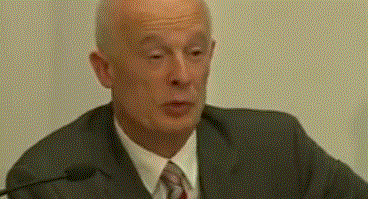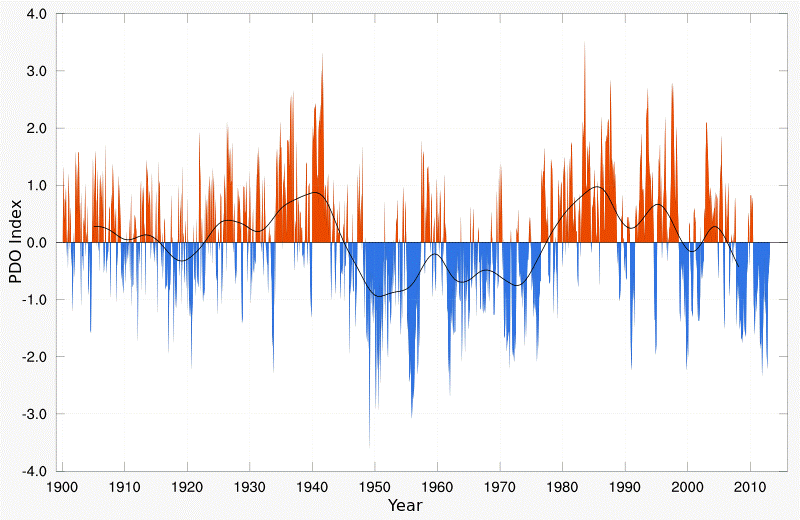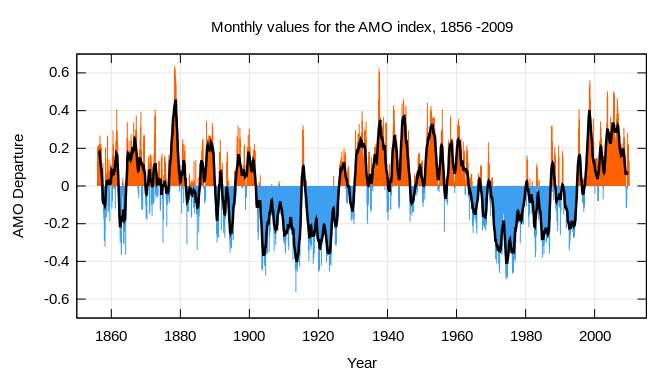Yesterday here I wrote about some comments made by Hans-Joachim Schellnhuber at a press release last week on the first day of the World Conference on Climate Impacts in Potsdam Germany.
Hans-Joachim Schellnhuber confirms that oceans are a major factor in global temperature. Image source: www.climate-impacts-2013.org/.
While answering a question from a journalist about why global temperatures have stagnated over the last 15 years, Schellnhuber blamed the cool oceans for absorbing the heat that everyone is missing and searching for.
At around the 35-minute mark of the video, Prof. Schellnhuber tells us (my emphasis):
So what we probably see now is a sort of saturation of deeper ocean layers, …but once the job is done, the surface will warm once again, and even faster actually later on. This is by the way accompanied by, if you look at the data as I did this morning, you had many more La Nina events, that is the cool phase in the Pacific, in the last decade then you had in the previous decade. This is in a sense precisely in a La Nina event the oceans more or less take up heat while in an El Nino event they release heat. So just wait for the next big El Nino and we will have again a boost in global temperature.”
First it is clear that Prof. Schellnhuber doesn’t really know where the heat is, and is only assuming that it is hidden at the “deeper layers of the ocean“.
Secondly, and more importantly, he tells us that La Ninas take up heat from the atmosphere and that El Ninos release heat into the atmosphere. “So just wait for the next big El Nino and we will have again a boost in global temperature.” Clearly he is telling us that the oceans indeed do have a big impact on global temperature. So why hasn’t he included this in the models?
If Schellnhuber agrees that El Nino Southern Oscillations (ENSO) leave their mark on global temperature, then he cannot possibly deny that the PDO and AMO phases do the same. In cool phases they remove heat from the atmosphere, in warm phases they release heat into the atmosphere. Schellnhuber acknowledges this. We’ve been measuring this for decades now.
The following chart shows the PDO:
The positive PDO released gargantuan amounts of heat into the atmosphere from 1980 – 2006, a time when global temperature jumped 0.5°C. Chart source: Giorgiogp2, data from jisao.washington.edu/PDO.latest, the Creative Commons Attribution-Share Alike 3.0 Unported license.
The chart above clearly shows that the massive equatorial Pacific was releasing mega-heat into the atmosphere from 1980 – 2007. This heats up the global atmosphere just as Prof. Schellnhuber describes above. The question is what factor got all the credit for that heat? The PIK and many warmist scientists wrongly assigned it to CO2. But now that the globe has stopped warming, they are blaming the oceans.
Why was the heat released by the 1980 – 2007 positive PDO not properly assigned in the climate models? No wonder the models look like jokes today. Schellnhuber needed the PDO heat in order to make CO2 look bad. It was the only way to come up with a dangerously high CO2 climate sensitivity.
The same applies with the Atlantic Multidecadal Oscillation (AMO):
AMO climbed from 1975 until 2000. Public domain chart
So the heat that was added by the positive PDO and AMO since 1980 has to be subtracted from the CO2 account. If you do that, then you will see that CO2 climate sensitivity is far less, and is no longer a problem.
Good to see that Schellnhuber acknowledges the AMO and PDO. All he has to do now is build them into his climate models.








Today, with record flood in Central Europe, and Prof. Schellnhuber does not know how the Western N-Atlantic, and North- and Baltic Sea influence this drama, (03 June 13), see
___SST anomaly North Atlantic http://seatraining.net/e/b/7_4_1.jpg
___SST anomaly North Sea & Baltic: http://seatraining.net/e/b/7_4_2.jpg , showing a big temperature difference and
___Satelliten image Europe http://seatraining.net/e/b/7_4_3.jpg
indicating quite clearly that cold SST stop moisture air moving from the east westwards, but pour plenty water eastward from the line Marseille, Kassel, Berlin, he does not know much about the influence of the seas and oceans.
Right now on ARD “Hart aber fair“ discussion about flooding and cc. One guest…Prof. Lativ. 🙂
Ike
Did Lativ claim that the flood waters are warmer than before? 🙂
Have you seen this
http://www.bbc.co.uk/news/science-environment-22745578
“Energy Secretary Ed Davey is to make an unprecedented attack later on climate change sceptics.
In a speech, the Lib Dem minister will complain that right-wing newspapers are undermining science for political ends.”
Pot to kettle!!!
You mean this one? https://www.gov.uk/government/speeches/edward-davey-speech-climate-change-acting-on-the-science
Also see here: http://tallbloke.wordpress.com/2013/06/03/ed-davey-has-his-knickers-in-a-twist-about-climate-sceptics/
I think he’s the last idiot to believe the Cook survey.
“Good to see that Schellnhuber acknowledges the AMO and PDO. All he has to do now is build them into his climate models.”
It looks to me like the global warmist-communitarian movement works actively to not measure data, suppress measuring efforts and ignore measurements already taken – because every bit of new data discredits the models more and endangers the communitarian project.
Look into the wikipedia and try to find a page about ERBE. Nothing. We know who controls the wikipedia. What a surprise.
Expect more data to vanish.
They have to be extremely worried about their deteriorating position, observations are such that even a caveman could understand what is coming!
It’s not just oceans – all of Earth’s climate is governed by natural cycles.
Nearly everyone, (including myself until a year ago) is still sucked into the line of thinking first thrust upon the world by the AGW crowd, namely that it is all to do with radiative forcing. Yes, this includes virtually all other PSI members..
I have been thinking this through for a long time and am now firmly of the opinion that all these energy budgets are incomplete, mainly because they don’t show the missing link. On Venus and Uranus that missing link is a huge amount of energy which must flow downwards in the atmosphere. It’s quite a lot on Earth too. Over the life of these planets there has been a build up of thermal energy from the Sun which can’t escape.
So these planets (Uranus, Venus, Earth) are not still cooling off. It’s cold out there where Uranus is because it only receives about 3W/m^2 in the very top of its atmosphere. It could easily have cooled off, but for the one thing that stops it. And that one thing is the gravitationally induced thermal gradient which forms by diffusion at the molecular level,, because molecules in free flight between collisions interchange kinetic energy and gravitational potential energy. In just two lines of calculations, you can derive the -g/Cp value by equating PE and -KE. Kinetic energy will tend towards being homogeneous during collisions, but only at each altitude. Inter-molecular radiation reduces the gradient by up to about a third, but by less than 5% on Uranus where there is just a little methane causing that.
The Clausius (hot to cold) statement of the Second Law is not comprehensive and for conduction and diffusion it only applies in a horizontal plane. The process described in the Second Law means that thermodynamic equilibrium evolves spontaneously, and, in the process of maintaining such equilibrium there must evolve a temperature gradient. Most importantly, extra energy absorbed at higher altitudes can actually flow up this gradient because that will help restore the equilibrium.
[…] Schellnhuber Slips, Confirms Ocean Cycles Do Play A Major Role, Yet Hasn’t Added Them To Clima… (notrickszone.com) […]